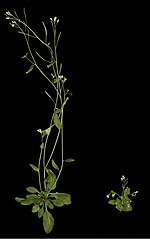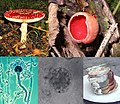Tolerance is the ability of plants to mitigate the negative fitness effects caused by herbivory. It is one of the general plant defense strategies against... 37 KB (5,335 words) - 11:44, 7 December 2023 |
 | Plant defense against herbivory or host-plant resistance (HPR) is a range of adaptations evolved by plants which improve their survival and reproduction... 97 KB (11,260 words) - 23:56, 25 March 2024 |
Plant defense may refer to: Plant defense against herbivory Inducible plant defenses against herbivory Plant tolerance to herbivory Plant use of endophytic... 353 bytes (66 words) - 23:14, 20 October 2023 |
Immunotherapy Infectious tolerance Mithridatism Plant tolerance to herbivory Medawar P (December 12, 1960). "Nobel Lecture: Immunological Tolerance". The Nobel Prize... 50 KB (6,024 words) - 06:02, 29 April 2024 |
 | Herbivora is derived from Latin herba 'small plant, herb' and vora, from vorare 'to eat, devour'. Herbivory is a form of consumption in which an organism... 53 KB (6,209 words) - 17:22, 10 April 2024 |
Plants and herbivores have co-evolved together for 350 million years. Plants have evolved many defense mechanisms against insect herbivory. Such defenses... 14 KB (1,981 words) - 05:06, 29 August 2023 |
 | all aspects of plant growth and development, including embryogenesis, the regulation of organ size, pathogen defense, stress tolerance and reproductive... 56 KB (7,033 words) - 05:45, 6 May 2024 |
which kills caterpillars. Many plants give off such herbivory-induced signals. Plants secrete a variety of chemicals to help seal off damaged areas. For... 14 KB (1,480 words) - 18:57, 11 April 2024 |
 | flowering plants, but it can be beneficial; it can stimulate plant growth, improve tolerance of oxidative stress, and increase resistance to pathogens... 57 KB (7,336 words) - 18:48, 6 March 2024 |
the dropping stimulus didn’t pose a threat of herbivory. Gagliano then tested to see how long the plant could retain the information for. She waited a... 27 KB (3,797 words) - 04:40, 28 February 2024 |
cases, invasive success was due not to release from herbivory but greater tolerance of it. The ERH is closely related to two other important theories for... 17 KB (2,096 words) - 06:44, 11 January 2024 |
affecting the spatial distribution of different plant species. For example, the impact of herbivory is typically more pronounced in grassland species... 22 KB (2,559 words) - 05:29, 15 April 2024 |
discovered that the longer herbivory continued the higher the accumulation of jasmonic acid in wild-type plants and in silenced plants, the production of more... 24 KB (2,829 words) - 10:59, 1 February 2024 |
 | early spring. The two species that create a hybrid form as a response to herbivory from leaf beetles are Rhododendron periclymenoides and R. atlanticum... 6 KB (574 words) - 11:52, 30 January 2024 |
 | Jasmonate (category Plant hormones) development. In particular, JAs are critical for plant defense against herbivory and plant responses to poor environmental conditions and other kinds of... 23 KB (2,887 words) - 14:05, 14 April 2024 |
 | Invasive species (redirect from Mechanisms of Plant Invasion) extinction has resulted in dysfunctional ecosystems with respect to seed dispersal and herbivory. On the offshore islets of Mauritius, tortoises now extinct... 126 KB (12,994 words) - 21:52, 7 May 2024 |
Siemann, E. . 2008. Increased competitive ability and herbivory tolerance of the invasive plant Sapium sebiferum. Biological Invasions 10:291–302. Nijjer... 4 KB (548 words) - 15:56, 17 April 2024 |
 | Anthocyanin (section Plant physiology) anthocyanins is relatively high, plants benefit significantly from the environmental adaptation, disease tolerance, and pest tolerance provided by anthocyanins... 47 KB (4,582 words) - 04:33, 18 April 2024 |
 | Asclepias (category Butterfly food plants) Defense of Milkweeds against Monarchs - Latex, Cardenolides, and Tolerance of Herbivory". In Oberhauser, Karen (ed.). Monarchs in a changing world: biology... 33 KB (2,677 words) - 02:15, 28 April 2024 |
 | Hyperaccumulator (category Phytoremediation plants) toxicity of other anti-herbivory metabolites. Metals are predominantly accumulated in the roots causing an unbalanced shoot to root ratio of metal concentrations... 18 KB (2,379 words) - 21:38, 29 February 2024 |
 | Endophyte (section Effects on plant behavior) host plant with issues such as pathogens and disease, water stress, heat stress, nutrient availability and poor soil quality, salinity, and herbivory. In... 53 KB (6,288 words) - 22:20, 30 March 2024 |
it is detrimental to the Escovopsis fungi. Antibiotic Biological pest control Biotechnology Symbiosis Plant defense against herbivory Secondary metabolite... 8 KB (838 words) - 03:21, 9 May 2024 |
 | Lolium arundinaceum (category Garden plants of Europe) detrimental effects to livestock while keeping the endophytic effects of reduced insect herbivory, disease resistance, drought tolerance, and extended growing... 21 KB (2,740 words) - 02:31, 9 April 2024 |
 | Pisaurina mira (section Heat tolerance) mira is able to hunt for other available insects. P. mira contributes to the increase of carbon storage by reducing grasshopper herbivory. The presence... 18 KB (2,367 words) - 17:37, 7 May 2023 |
 | Acer platanoides (category Plants described in 1753) Invasive Plants" (PDF). C. L. Cincotta; J. M. Adams; C. Holzapfel (2009). "Testing the enemy release hypothesis: a comparison of foliar insect herbivory of... 23 KB (2,433 words) - 13:49, 6 May 2024 |
 | Fungus (redirect from Fungus Plants) alkaloids that are toxic to a range of invertebrate and vertebrate herbivores. These alkaloids protect grass plants from herbivory, but several endophyte... 201 KB (19,250 words) - 21:28, 14 May 2024 |




